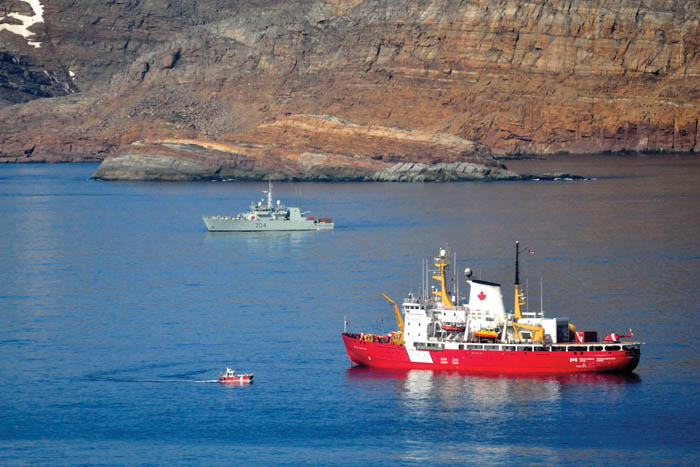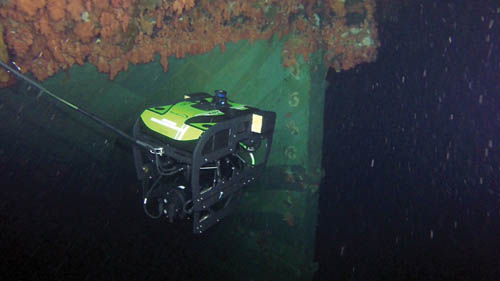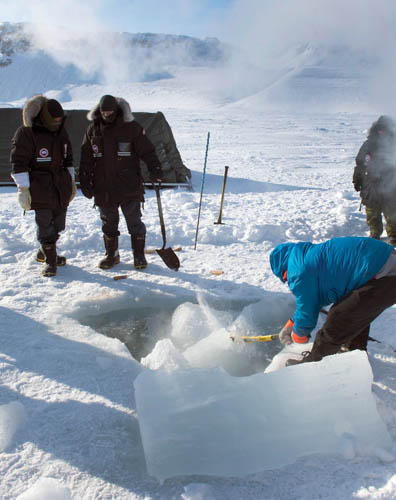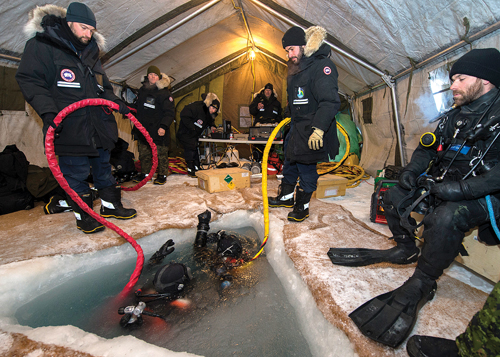Modern technology meets old in the depths of a frigid sea
Clearance divers of the Royal Canadian Navy’s Fleet Diving Unit (Atlantic), with a little help from their nimble little ROVs, revisit the remains of HMS Breadalbane during the military’s annual arctic readiness exercise – Operation Nunalivut 2014

A dive into the past serves the future. That’s how clearance divers from the Royal Canadian Navy’s Fleet Diving Unit (Atlantic) saw it during their recent sojourn high above the Arctic Circle. As part of the Canadian Armed Forces annual arctic readiness exercise – Operation Nunalivut – they revisited a very old shipwreck that is assuredly one of the least visited National Historic sites in Canada.
We’re referring to HMS Breadalbane of course, the world’s most northerly known shipwreck, which DIVER revisited as well last year in Volume 38 Number 6 to commemorate a 30th anniversary. The story recounted the adventures of publisher Phil Nuytten who headed up dive operations for a spring 1983 expedition, the first ever on the long lost wreck. That account was first published later the same year. Led by Dr. Joe MacInnis, the civilian initiative revealed the remarkably intact wooden sailing ship to the world, on the cover of National Geographic magazine no less.
Call us biased, but we reckon the Fleet Diving Unit’s recent jaunt into the frosty north to ‘drop in’ on the Breadalbane, complete with ROVs, was hands-down the most interesting event of the month-long operation, staged April 2 through May 3. The 19th century sailing ship is anything but your average wreck dive. Located in 328 feet (100m) of water just south of Beechey Island, she was first filmed in 1981 (stills had been taken by drop camera to confirm her identity the year before) by another ROV, which captured more than 500 photos and three hours of colour videotape as it zipped around the old British barque, a supply ship in her day.

Sharp New Video
During this April’s month-long operation the clearance divers logged 21 dives and 14 hours under the frigid arctic sea by way of an ice hole cut through the 5-foot (1.5m) thick ice cover. Their preparedness efforts involved deployment of ROVs whose technology has advanced significantly over the past three decades. That was apparent in the images they recorded with more than 25 hours of digital footage of the stately wreck that remains intact, upright on her keel and is a burst of colour to boot thanks to the marine life that now adorns her wooden frame.
This recent series of photo dives on HMS Breadalbane are the first since the original 1983 expedition and, in turn, the first look at the 19th century barque in more than three decades. Acquiring these images the Canadian Armed Forces worked in cooperation with Parks Canada’s Underwater Archaeology Service and California-based SeaBotix, Inc. The entire archive of digital imagery and associated data recorded during the exercise will be shared with and preserved by the Government of Nunavut and Parks Canada.

Ill-fated Arctic Ship
Breadalbane was among many ships dispatched mid 19th century by Queen Victoria on a vital rescue mission. She was tasked to find Sir John Franklin and the men of his ships Erebus and Terror, which had disappeared during the acclaimed arctic explorer’s third attempt to navigate Canada’s Northwest Passage from east to west, in hopes of proving the viability of a faster and, therefore, more lucrative trade route to the Orient. The arctic got the better of him and his ships, which remain lost to this day (although a search has been underway for the past several summer seasons). Discovery of the Franklin ships would be a major historical find for Canada and the world. As a part of that ongoing initiative, another Royal Navy rescue ship, HMS Investigator, was discovered in the western arctic at Banks Island by the Underwater Archaeological team of Parks Canada.
It was in 1975 that Dr. Joe MacInnis began his archival research in the quest to find the Breadalbane. That effort led to her discovery in August 1980 and the spring 1983 expedition referred to above earlier in the story.
After viewing a video clip of the dives on Breadalbane this April, MacInnis was quoted in Canada’s National Post newspaper saying, “It’s a ‘wow’, there’s no question about it, it is a definite ‘wow’.” Recalling the photographic technology available 31 years ago, he said, “You see the detail here, a crispness that we just didn’t have in 1983. You can see the hull’s copper sheeting in clear detail… these images are twice as good, maybe more, than what we shot.”
MacInnis worked as a physician to filmmaker James Cameron on his 2012 solo dive in Deepsea
Challenger to the bottom of Challenger Deep in the Mariana Trench, deepest spot in the world ocean. His interest and involvement in the arctic was focused on finding a shipwreck, in the broader context of Canadian arctic sovereignty, which also backstops Operation Nunalivut.
“The thing now is, what’s the next step?” MacInnis said in his newspaper interview. “How is this story going to be told and shared with all Canadians? That’s the most important thing.”

Joint Task Force
Operation Nunalivut is one of Joint Task Force (North)’s annual operations in the high arctic, combining Air, Land and Maritime operations to exercise interoperability and arctic skill-sets within the Canadian Armed Forces (CAF). Parks Canada, Natural Resources Canada (Polar Continental Shelf Program), the Government of Nunavut, and SeaBotix Inc. were valuable participants in this year’s exercise. The annual exercises are part of the CAF’s ongoing presence in the north over the decades, conducting surveillance and sovereignty operations and contributing to a more visible government presence.
Leave a Comment







